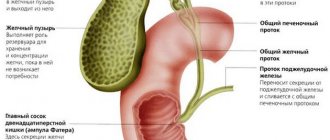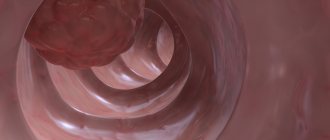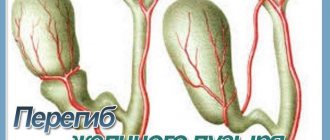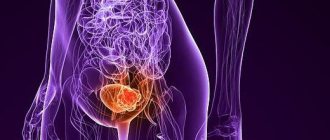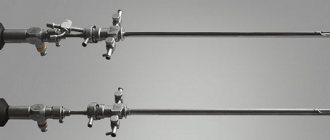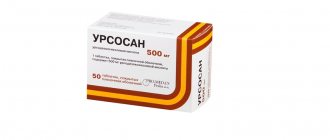Pathogenesis of the disease
When bile stagnates in the gallbladder as a result of a violation of its outflow, the composition of the fluid changes. It begins active life and reproduction of infectious agents. Gradually, internal pressure on the walls of the organ increases, which leads to an inflammatory process and the formation of pus.
At this stage, when pus forms, cholecystitis turns into a phlegmonous form. This stage is already called destructive, as it leads to significant, and largely irreversible, changes in the structure of the organ.
Inflammatory effusion and pus permeate the walls of the organ, which leads to its thickening. In the phlegmonous form, numerous small hemorrhages and foci of purulent process appear in the walls. Inflammation leads to pathological changes in the mucous membrane: scars begin to form in it at the sites of necrotic processes.
The walls of the organ, under the influence of internal pressure, expand, bile with admixtures of mucus, pus, and also stones, if cholecystitis is calculous, bursts and enlarges it. A characteristic feature that distinguishes the phlegmonous form of the disease from the catarrhal form is the presence of white or yellowish purulent contents in the gallbladder.
The purulent process proceeds rapidly, the liquid fills the bladder, inflating it and making its walls tense. This is the main reason for increased pain.
Specific signs revealed during examination
If the patient has acute cholecystitis, diffuse pain may be observed in the upper abdomen, more so in the right hypochondrium. An enlarged bladder can also be felt here.
One of the evidence of acute inflammation is the positive Zakharyin symptom for cholecystitis. The sign is determined by tapping the gallbladder area. If the symptom is positive, there is an increase in pain.
During the examination, other positive symptoms may be detected:
- Grekov-Ortner. The method consists of tapping the side of the palm on the costal arch above the affected area. For comparison, similar actions are performed on the left.
- Courvoisier. When palpating the area of the right hypochondrium, an elongated bottom part of the bile duct is determined. It protrudes slightly beyond the liver.
- Murphy. The doctor lowers one finger onto the area of the bladder, and places the rest along the patient’s costal arch. At the moment of taking a deep breath, severe pain occurs that does not allow you to complete the action.
- Pekarsky. Increased pain is observed upon palpation of the xiphoid process - cartilage located between the ribs, in the lower part of the sternum skeleton. An affirmative result is a sign of a chronic process or its exacerbation and is explained by the involvement of the solar plexus muscles in the pathological process.
- Boas. The pain intensifies when palpating the paravertebral area. The action is performed in the area of 9-11 thoracic vertebrae, with a distance of 3 centimeters from the spine.
- Mussi-Georgievsky. When pressing on the hole above the right collarbone (in front), the patient feels a sharp pain in the side. At first glance, the area of influence is not related to digestion. But above the collarbone there are nerve endings intertwined with the neurons of the internal organs lying below.
- Lepene. The pain intensifies when tapping in the area of the diseased organ. The action is performed with the right index finger.
- Riesman. Unpleasant sensations intensify when tapping on the right costal arch. The manipulation is carried out with a deep breath followed by holding the breath.
- Kera (Vasilenko syndrome in the early stages). Impact on the costal arch on the right causes increased pain. Diagnosis is carried out at the moment of inhalation.
Obraztsov’s symptom for cholecystitis is also informative. The study is carried out by applying pressure with the hand to the area of the right hypochondrium of the patient lying on his back. If raising the right leg increases the pain, the result is positive.
Tension in the walls of the abdominal cavity indicates dangerous conditions that threaten life. If, when pressing on the abdomen and sharply removing the hands, the painful sensations intensify, they speak of an affirmative result according to the Shchetkin-Blumberg method. It indicates the development of peritonitis and appendicitis.
With diffuse inflammation of the peritoneum, the pain has no clear localization and is felt throughout the abdomen. With limited localization of cholecystitis, discomfort is felt mainly in the affected area. With inflammatory pathology in the liver area, pain is determined on the right.
Specific signs of the disease make it possible to establish the presence of inflammation. An examination will be required to identify its cause and concomitant diseases. If peritonitis or other dangerous conditions are present, emergency surgery is needed.
Clinical picture
The course of the purulent process is always characterized by a significant increase in general and local temperature. The patient shows signs of intoxication. the inflammatory process goes beyond the affected organ and begins to negatively affect the condition of the entire body. In the phlegmonous stage, pain intensifies.
Pain sensations become especially pronounced if the patient violates the diet, takes alcohol, or is exposed to excessive physical activity. Also, the cause of increased pain can be emotional overstrain, a stressful state.
Acute calculous phlegmonous cholecystitis occurs with the following symptoms:
- vomiting the contents of the stomach and gall bladder,
- arterial hypotension,
- general weakness, decreased tone,
- bouts of cold perspiration,
- feeling of the taste of bile in the mouth, bitter belching,
- changes in the characteristics of urine and feces.
Painful sensations occur in the right side and intensify with changes in body position and deep breaths. At this stage of the disease, the symptoms of the catarrhal form intensify: vomiting becomes more frequent, the pain is stronger, and tachycardia is observed. In some cases, abdominal bloating is noticeable due to impaired functioning of the smooth muscles of the intestine.
Prevention
For preventive purposes, to reduce the likelihood of developing phlegmonous cholecystitis, the patient is recommended to follow medical recommendations in treatment and lifestyle. The pathology is often a complicated form of stone cholecystitis. Therefore, throughout life, the patient must adhere to certain rules to avoid relapse:
- follow a diet;
- do not abuse physical activity;
- normalize the psycho-emotional background;
- take recommended medications;
- Periodically visit a doctor and undergo the necessary examinations.
On a note! If the patient consults a specialist at the stage of stone formation, then if the recommendations are followed, the development of phlegmonous cholecystitis will be avoided.
Diagnostic measures
First of all, the doctor studies the patient’s medical history. The phlegmonous form always develops from the catarrhal form, and cholecystitis itself in 95% of cases is a complication of the presence of stones in the ducts of the organ. During physical examination of the patient, slight abdominal distension may be felt. When palpating the right hypochondrium, the patient experiences severe pain. The doctor can also feel the inflamed gallbladder.
General blood and urine tests are required. During the inflammatory process, the ESR accelerates and the content of leukocytes increases. Depending on the values of these indicators, the stage of the pathological process can also be determined. A biochemical blood test is also performed to identify signs of cholestasis.
To visually assess the condition of an organ affected by inflammation, methods such as ultrasound and radiographic examination, computed tomography and magnetic resonance imaging are used. In difficult cases, a biopsy is prescribed. To clarify the diagnosis, additional endoscopic examinations and duodenal intubation can be performed.
Diagnostics
To make an accurate diagnosis, the doctor examines the patient and palpates the abdomen to identify symptoms characteristic of the disease, namely:
- Kera – pain when lightly pressing on the area of inflammation;
- Mussi-Geogrievsky - when examining the neck, pain appears under the ear, which radiates to the right half of the abdomen;
- Murphy – when pressing in the area of the gallbladder and inhaling, pain appears.
Definition of Murphy's symptom
The patient also needs to undergo a general blood test, which makes it possible to determine the established disease by an increased number of leukocytes.
When diagnosing any form of cholecystitis, the doctor prescribes various instrumental and laboratory tests, since the indicated symptoms can also determine other pathological conditions. The doctor must carry out a differential diagnosis, since calculous cholecystitis of the gangrenous and phlegmonous type is similar to the following pathologies:
- appendicitis;
- pancreatitis;
- ulcer.
Treatment of phlegmonous cholecystitis
Patients with phlegmonous cholecystitis must be hospitalized.
The treatment is complex, aimed at several goals at once. The symptoms of the disease are very acute, so first of all it is necessary to eliminate the manifestations. Therapy is also prescribed aimed at eliminating the provoking factors of the disease.
In the vast majority of cases, only surgery helps. The tactic of waiting and using exclusively drug treatment is practiced only in the catarrhal stage. In the phlegmonous form, drug therapy is used to eliminate acute symptoms and maintain the patient’s condition and strengthen the immune system.
Antibiotics are used to suppress the activity of infectious agents. They are selected depending on the type and type of pathogen. To eliminate intoxication of the body, sorbent drugs are prescribed. Analgesics and antispasmodics are used to relieve pain.
To stop the inflammatory process, non-steroidal drugs are used. Antiemetic drugs are also prescribed. To support the body in the fight against the infectious process, immunomodulators are prescribed.
Symptoms
If advanced calculous cholecystitis is established, which begins to develop into phlegmonous ulcerative cholecystitis, the patient feels very bad. The symptoms are as follows:
- Intense pain on the right under the ribs, which intensifies with deep breathing, coughing or movement.
- Nausea with constant vomiting.
- Purulent pathology develops rapidly and causes an increase in temperature to 38 degrees, which can last for several days.
- Rapid pulse, weakness.
- During the phlegmonous stage of cholecystitis, the abdomen is swollen and painful. When palpating the right half of the abdominal wall, significant tension is observed.
- The tongue is dry and coated.
If these symptoms are observed, seek emergency medical help immediately. Any delay will lead to a deterioration in the patient's condition or even death.
Diet
An important point in the treatment of the disease is nutrition. During an exacerbation, it is recommended to completely stop eating food for one to three days. Such measures are taken only on the recommendation and under the supervision of the attending physician.
Subsequently, the patient is transferred to a gentle diet, excluding spicy, fatty and salty foods. All food that irritates the digestive tract is prohibited for consumption.
Meals are fractional, in small portions. To facilitate the work of the gastrointestinal tract, dishes should be pureed or chopped as much as possible.
Surgery
Surgical interventions are almost always indicated at the phlegmonous stage of cholecystitis. The indications are:
- loss of organ functionality,
- complex course of pathology,
- frequent relapses.
Most often, patients are advised to surgically get rid of the source of the disease - the affected gallbladder itself. In severe cases, to alleviate the patient’s condition, installing a drainage system to drain purulent contents is used.
Cholecystectomy can be performed in two ways: laparoscopy or open abdominal surgery. If surgical intervention is not possible, for example, in very elderly or seriously ill patients, stone crushing may be performed.
Such treatment can be carried out with the help of medications or a special device. However, in such cases there is always a risk of re-formation of stones. Possible complications
In the absence of adequate treatment, serious consequences can occur. The most likely outcome in this case is the progression of the disease, when cholecystitis changes from phlegmonous to gangrenous.
In this form, the disease can cause death. When gangrene occurs, the wall of the gallbladder is perforated, which can cause bile to leak into the abdominal cavity.
With timely and competent treatment, the consequences are not so serious, but the development of complications is still possible. The likelihood of this depends on the age and general condition of the patient, the presence of concomitant diseases and the characteristics of the pathological process. If phlegmonous calculous cholecystitis is diagnosed, its progression can lead to the development of empyema of the gallbladder. This can happen when the inflammation is stopped, but the duct remains obliterated or blocked by a stone.
In some cases, scarring and proliferation of connective tissue leads to the development of sclerotic changes in the gallbladder. This condition causes the walls of the organ to thicken and lose their elasticity.
Multiple scar formations make the walls of the bladder unable to contract. The organ gradually transforms into a dense sac, inside of which there is pus, sand, and stones. If there is no contents in the bladder, it can become a nonfunctional lump of fibrous tissue tightly attached to the liver.
Sometimes phlegmonous calculous cholecystitis leads to calcification of the walls of the gallbladder. In this case, it becomes dense and hard; this state is also called a “porcelain” bubble.
Causes
There are 3 ways of pathology development. The main ways the infection spreads are:
- Hematogenous - in this case, the infection enters the gallbladder through the blood supply through the hepatic artery. The greatest accumulation of microorganisms in this case is observed in the Luschka passages.
- Lymphogenic - microorganisms penetrate into the bladder and ducts through the lymphatic system.
- Ascending - the infection spreads from other foci.
The main reasons for the development of acute cholecystitis include:
- blockage of the bile ducts with stones (90-95% of cases);
- age over 50 years;
- eating large amounts of fatty foods;
- sedentary lifestyle;
- obesity;
- pregnancy;
- diet abuse;
- prolonged fasting;
- presence of helminthic infestations;
- diabetes;
- gastritis with low acidity;
- taking hormonal drugs;
- blood changes;
- sepsis.
Although the disease can occur for numerous reasons, most often the pathology develops due to infections. A prerequisite for the development of acute cholecystitis is stagnation of bile in the bladder, for example, as a result of kinks or narrowing of the ducts, as well as blockage with stones.
In almost 90% of cases, the pathology develops against the background of cholelithiasis.
Consequences of phlegmonous cholecystitis
It should also be noted that the phlegmonous stage of cholecystitis does not go away without a trace even with successful treatment, since the changes occurring in the inflamed organ are irreversible. With any outcome of the disease, the walls of the organ become denser and less elastic. In areas of the inflammatory process, the mucous membrane becomes thinner, and small ulcers form on it.
The smooth muscle of the gallbladder also undergoes pathological changes. It becomes thicker and denser as a result of the proliferation of connective tissue. If the process takes a chronic form, then with each new relapse these changes worsen.
Etiology
The following factors contribute to the development of the disease:
- changes in the composition of bile;
- bile stagnation;
- recurrent inflammatory processes.
The formation of phlegmonous cholecystitis is possible if the primary inflammation of the gallbladder was not treated or the wrong treatment regimen was chosen. Infiltration of the gallbladder and the presence of ulcerative formations on the mucosa will indicate the formation of a complicated form of pathology. During this period, the wall of the organ thickens, the bladder increases in size and pus accumulates.
